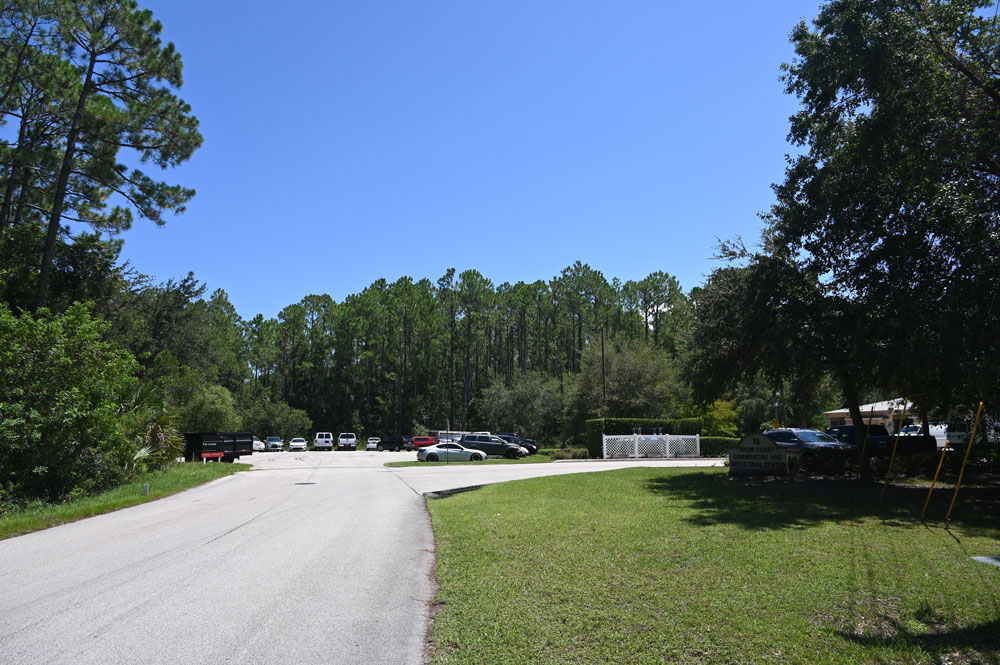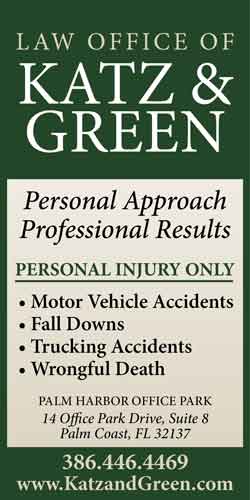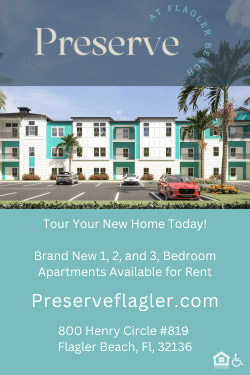
Facing down sharp opposition, especially from business owners off Hargrove Grade, the Palm Coast City Council in a 3-2 vote Tuesday approved on first reading the rezoning of 37 acres at the western edge of Hargrove from light industrial to heavy industrial ahead of the construction of a concrete mixing plant there.
The city’s planning board rejected the rezoning in June, citing pollution that could affect businesses on Hargrove, and the negative effects the plant could have on acreage along Hargrove owned by AdventHealth: the board did not want to discourage the hospital company from building a medical park there.
Hargrove Grade is an industrial road rimmed by light manufacturing businesses, auto shops and warehouses. It extends (and dead-ends) west from U.S. 1, just north of Palm Coast Parkway. Businesses along Hargrove are concerned that the concrete plant will shower the area with particulates that could damage their operations, increase traffic with rumbling concrete trucks, and set a precedent of heavy-industrial zoning in an area they consider unsuited for it. Some acreage further west of the area in question is already zoned heavy industrial.
“While I support responsible growth, this proposal is incompatible with the character and function of the existing businesses that are already there,“ said Renee Hunter, who represented Autohaus of Palm Coast, a business on Hargrove Grade, told the council. She had spoken her opposition to the planning board, when her chief worry was the particulates that could damage the work done at her business. She did not mention particulates this time. “Introducing heavy industrial to this area would disrupt balance, potentially lowering property values and creating operational conflicts and a very real possibility of financial ruin for many,” she said.
In an unusual alignment, Mayor Mike Norris and Council members Dave Sullivan and Charles Gambaro voted in favor of the rezoning. Council members Theresa Pontieri and Ty Miller voted against.
Pontieri cited the Land Development Code to note that at least 53 businesses could be affected by the rezoning, an impact that runs counter to the LDC’s requirement that a rezoning may not damage the operations of existing businesses. She as also concerned about “setting a very dangerous precedent. It will be that much harder to say no to the next one, which, by the way, is on the heels of this one: they’re going before the planning board tomorrow.”
Michael Hanson, a city planner, presented the requested rezoning to the council. The concrete plant would use either 10,000 gallons of water per day or 14,000 (there was an inconsistency in the documentation). The hydrologist for the project recommended placing the well that would draw water for the plant to be placed as far away from existing municipal wells as possible. The city’s well-protection regulations require non-city wells to be at least 500 feet away. The company would drill a well drawing five to 15 gallons per minute, giving it the potential to draw up to 21,600 gallons in a 24-hour period. Bu the concrete company will have a 10,000-gallon tank at the site and recycle water.
“The proposed rezoning would allow the property owner to potentially develop a concrete batch plant,” Hanson said. “I say potentially, as any kind of rezoning is conceptual nature. So concrete batch plant is an allowed use for the heavy industrial use.” But so would be other heavy industrial uses.
The plant would likely quadruple property tax revenue generated from the parcel and, according to Hanson, add about 10 jobs. When presented to the planning board, the project was said to bring 30 to 50 jobs.When SRM Concrete’s Brian Hercules appeared before the council Tuesday, he said there’d be a start-up of 10 to 12 people, growing to 18 to 20.
Hercules said the company produces blocks and is in the “aggregate” business, with over two dozen quarries that produce rock and sand. He said a concrete batch plant is not a cement plant. “If I was here representing a cement plant, run me out of town,” he said. Batch plants are different. The proposed plant would use five to six acres of the parcel, leaving ample natural buffer, and include a dust-collection system. “Does a ready-mix plant produce a lot of dust? No, but at one time, they did,” Hercules said. “There may be some others in the community that are older plants that still operate that way. But we’re talking about building a brand new state of the art plant.” The “Stevens” system collects an almost totality of particulates, he said. No water is released at the site.
Pontieri asked a series of clarifying questions–on buffers, entry and exit, truck traffic intensity, water usage, and whether Hargrove Grade may need to be improved after so much truck traffic (“not really on an industrial road,” Hercules said.) Pontieri will be looking to include stricter requirements in the development order, once the project gets to that point.
“Say it’s operating and there is particulates being generated that are going on to other properties. What recourse do we have in terms of code to correct that issue after it’s operating?” Miller asked. Hanson said it would be handled by the city’s code enforcement.
Curt Wimpée, a local resident and a civil engineer working on the project, represented the concrete company, as did Hercules. Wimpée said there’d be a truck every seven to 10 minutes (or every five to seven minutes on a busy day, according to documentation). “We didn’t even need to do a traffic study because the trips were so low,” he said. “Hargrove Grade was set up to be an industrial area that was put in there, and all of that zoned industrial for industrial uses just like this, and the traffic was accounted for.”
The dozen-odd business owners and operators who addressed the council opposed the rezoning. All operate in the Hargrove Grade industrial park, most off Hargrove Lane, such as Jeff Knapp of Encompass Enclosures. “This is a rezoning,” he said. “Concrete plant is one thing, but that concrete plant can go away and anything else can come in its place.” Another Hargrove Grade business operator described it as “a substantial escalation in the intensity of use, and introduces serious concerns regarding compatibility with the surrounding existing community.”
Other long-time business owners and operators from Hargrove Grade spoke–a pool construction operator, an air conditioning business and others–describing thriving business activity now possibly in jeopardy. “This one business may promise employment for 20 to 30 people, but within our industrial condominium alone, there are approximately 30 businesses employing well over 150 people,” one business owner said. “Prioritizing one business at the expense of many others doesn’t serve broader economic interest of the area.”
One business owner who serves on the board of the commercial industrial park, representing 68 businesses that collectively employ up to 150 people, said the group spent 20 years building those businesses. “We are the American dream,” he said. “We all agree about the need for more industry, but please don’t hurt the industry we already have. Turning that land into mixed-use over there would benefit the area greatly.”
The council is to vote on the second reading of the rezoning ordinance in two weeks.
![]()




























Using Common Sense says
For Mayor Norris to vote yes on this rezoning flys in the face of any claim to be “for the local residents”. Despite the heartfelt and valid concerns of the local business owners and employees, Mr. Norris ignored them all and voted for this incompatible zone change. Heavy industrial uses have a greater potential for environmental harm and are more likely to be a threat to human health and safety. Let’s hope Mayor Mike does the right thing and recognizes the importance of the safety, health, and welfare of the local businesses, their customers, and their workforce and changes his mind and votes NO on second read.
Jane Gentile Youd says
Disgusting. Absolutely a disgusting abdication of obligations to the citizens of Palm Coast especially the adjacent hard working business owners, Disgusting is too kind a word.
NC says
Like it or not we are all reliant on concrete. We live on top of it, drive on it, park on it, live inside it, etc etc. Where should it come from? Somewhere else right? Somewhere further.. somebody else’s backyard..
Palm Coast is sorely lacking in industrial or even heavy commercial property. It drives prices up for the limited parcels available and makes entrance into business or growth hard for those who didn’t buy property 10+ years ago or don’t want to drive 45 minutes to the yard.
The genie is out of the bottle on Florida. Growth is here. Just look at the map to the north or south. Beach to the river it’s all getting paved. All that requires concrete. It’s sad and I’m grateful I was born here and able to spend time in the woods before ‘yall’ got here but the reality is look around and it’s getting cleared and paved and folks are moving in.
This project SEEMS to be being done in the right ways re dust collection and water management. It’s out of the way but still centrally located with access to major roads. Maybe we could go back to semi nomadic hunter gathering and life under the thatched roof. Otherwise don’t think we’ll get to have our cake and eat it too
Andy Montgomery says
Excellent vote from our team leader Mr Norris. He only has residents not his best interest at heart. How many Palm coast worker men support Mike?
All 2000. Watch how he understands nothing but bbq. He can’t tell a city employee to go to Human Resources making a fortune because simple insurance is ridiculous to select and coat 30k after tax a year.
It’s broke folks.
Everything is broke.
And our world
Is
Late late
For a very important date
Slave to timeless time
Odd
Mike you and your VFW drinking buds, please leave our town to hum
Spew vile in your gatherings
Not our
Your already gone
Open thou eyes my son
🧚🏻♀️ the Goose your friend in Him
NJ says
Everyone in Palm Coast wants industry expansion to balance the tax but now NO one wants industry expansion NEAR their business. Palm Coast is the “CATCH-22” City in America! Planning, WHAT Planning!! We all heard of the “Deep State”, but we are all living in the “Deep City”! Time for FL DOGE of Palm Coast!!!
Billy says
Norris lost my vote ,just wait till all the dust from concrete is all over the area, heavy traffic ,heavy trucks. I believe Palm Coast will be Asphalt entirely within three or four years, it will become Orlando .
The dude says
Palm Coast: “We need more good, tax paying jobs and industry here so we can attract families and not be a city of olds relying on dwindling senior retirement and incomes!”
Interested business: “Ok, how about this?”
Palm Coast: “NO… we meant more service jobs and industry like grass cutting, waitstaff, and handy men!”
Pretty much every time.
hjc says
Drive down southbound US 1 into bunnell on the right you will see The titan concrete plant. You will see the roadway covered in spilled concrete and dust flying everywhere.